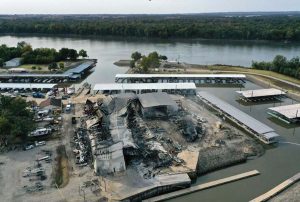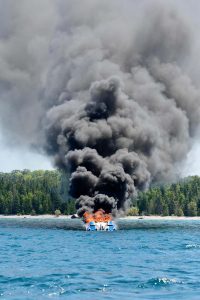
Part 2: Marina and Boatyard Fires – Prevention, Mitigation, and Response
Published on March 5, 2023Editor’s Note: This is the second article in a two-part series about marina fire prevention. The first article Part 1: Marina and Boatyard Fires – Prevention, Mitigation, and Response focuses on the common risks and causes of marina fires.
The previous article highlighted some of the common risks and causes of marina fires and the standards marina owners and operators should adopt and follow in order to help prevent a fire. The following are some regular fire scenarios for marinas and boatyards and some observations and prevention recommendations.
Storage Yard Fire: There is a concern for a lack of access to fight a fire in a jam-packed storage yard. Trying to access a row of boats that is behind another row (or two) of boats is practically impossible for responding firefighters. It is recommended that boats be placed in rows no deeper than two boats, with a fire lane behind the row of two and ahead of the row. That will give clear access for customers as well as first responders in the event of an emergency.
Again, no extension cords should ever be running to stored boats unless the boat owner/customer is present and using the cord. Make it a well-known rule that any unattended cords will be unplugged or simply disengage all exterior power outlets after the close of business. Adhere to the rule.
Inside Rack Storage: These fires typically cause utter destruction. Dry or wet suppression systems don’t seem to cut it, regardless of what any Authority Having Jurisdiction (AHJ) thinks or requires. In most cases, boats can’t be recognized after these types of fires. Engines (other than the iron blocks) are puddles of aluminum. When possible, battery switches should be turned to the “off” position on all rack stored boats. Ideally, marina owners and operators want to make the contents of the building as inert as possible. That means, no boats being serviced, no batteries charging, and no fuel or other hazardous materials being stored within the confines of the building.

Dock or Wet Slip Boat Fires: There are many concerns here. Lack of access being chief among them. Fire spread due to wind and close proximity is another. When it comes to a fire at a dock, it is shocking how fast the fire “jumps” from the origin boat to the adjacent boat. Generally, there is a lack of suppression materials available. NFPA 303 requires a fire extinguisher every 75 feet (in a protective and well-marked housing) in any one direction. That means 150 feet apart. There is an additional requirement for an extinguisher to be within 25 feet of the entrance to the dock, presumably for someone running to assist so it is within reach. But it is nearly impossible to suppress a fire on a fiberglass boat with a fire extinguisher unless it is very early on in the fire progression. It can also be very dangerous to stick around. Some docks are fitted with dry or charged lines. This is great if they are present and the fire crew knows how to use them. If not, then one option is to tow any boat involved away from the other boats. This, however, is also dangerous and takes training and experience. It may also open a marina up to other liabilities. But if it is done as a preservation, any potential plaintiff would be hard pressed to make that case.

In-Water Covered Docks: Covered shed fires are perhaps one of the deadliest. In 2017, fire ravaged the U Dock covered slips at Highport Marina on Lake Texoma in Pottsboro, Texas. It took minutes for the fire to spread from the origin vessel to more than 20 vessels in a fire that burned for hours, if not days.
In January of 2020, eight people perished in a covered shed fire in Jackson County, Alabama. Over 35 vessels were destroyed. Covered sheds, like indoor rack storage facilities, retain the heat and help spread the fire more rapidly than slips without covers. This is particularly true where the shed roofs are not vented. Heat and smoke retention make suppression activities particularly challenging. Essentially, the fire has plenty of oxygen entering the sides of the slip to sustain combustion, but the heat is trapped, thus further fueling the fire.
Fuel Dock or In-Water Fueling Fire: The causes of fueling fires can generally be

lumped into the following two categories: operator error and vessel or vessel maintenance issues. Common operator error issues include introducing fuel into orifices not intended to accept fuel, and not checking the bilge and/or engine compartment for fuel or fuel vapor after the fueling process has ended.
Fuel leaks at fill and fuel supply hoses, fuel tanks, and sending units account for the root cause of a large majority of fires. This goes back to operator error, however, because if the bilges and engine compartment were checked before introducing electricity to the equation (starting circuits, wiring or pumps), then the hazard would be recognized and steps to mitigate that hazard could be taken. The days of the high school or college kids on summer break casually manning the fuel dock in their shorts and t-shirts are over. The fuel dock is, perhaps, one if the biggest profit centers at a marina, but it can also be one of the most dangerous. Fuel dock attendants should be very well trained. They should know how to deliver the proper fuel to customers, but also know what to do in the case of an emergency. There must be an emergency plan. Every fuel dock operation must adhere to NFPA 30A.
Service Bay Fires: Ideally, the service bay should be away from other customer boats and property. This, of course, is not always feasible, so it is important to train the staff. Have fire suppression materials at the ready (more than recommended under NFPA 303 or NFPA 10) and train staff on how to use them. Again, no “hot work” unless tanks are properly gas freed. The local AHJ may require a certification prior to the commencement of work.
Prevention is Key
Train, train, train. There is no substitute for proper emergency training and that includes fire prevention and, if necessary, firefighting. There is a vast lack of experience within most professional firefighting communities in the handling of boat and marina/boatyard firefighting techniques. Most firefighters have never fought a fire on a dock or in a marina and most don’t understand the fuel loads and unique set of circumstances that a marina or boatyard complex can throw at them. So, invite the local fire department to the facility. Have a BBQ and combine that with a training session. Show them the docks, the access points, the main electrical disconnects (which, by the way should be well marked and not be behind dumpsters or other equipment) and other peculiarities of the facility. Developing this relationship now and conducting regular training with the local department is an essential tool to both minimize risk and prepare for the worst. NFPA 303 requires training of staff and record retention of that training. Fire prevention is everyone’s responsibility.
A fire is probably a marina’s worst nightmare. But, to be honest, it is also one of the most preventable catastrophes. Aside from the random wildfire, most fires are the result of someone overlooking something or not following the rules. With proper awareness, training, and action, marinas can minimize the risk and if the worst happens, minimize the exposure.
Daniel K. Rutherford, IAMI, CMI, LPI is the director of Claims and Risk Management at Maritime Program Group, a subsidiary of One80 Intermediaries. He can be reached at drutherford@maritimepg.com.
| Categories | |
| Tags |





